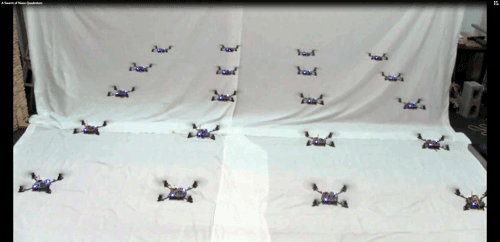Video: Quadrotor copters fly in groups and construct buildings
UPenn’s GRASP Lab improves famous flying bots, giving them capability to work together and construct buildings.
Daniel Mellinger, Vijay Kumar, and Alex Kushleyev, a team at the University of Pennsylvania’s GRASP Lab (General Robotics, Automation, Sensing, and Perception), in association with KMel Laboratories, have made huge strides recently in developing their popular quadrotor copters.

GRASP Lab’s quadrotor copters demonstrating the ability to fly together.
It was just a short time ago that they were making headlines in the tech world with these machines demonstrating the ability to fly in unison and move things around:
Today, with the incorporation of a unique algorithm and some additional parts, these bots are actually demonstrated the ability to work together and build small-scale structures.
Improvements
Each bot includes a gripper designed to pick objects up, and they can work together when lifting heavier objects. To do the actual construction, the quadrotor copter work from a preset algorithm. This is demonstrated in the video below, in which the bots work together to construct a cubic tower structure using specially designed parts that snap together via magnets:
Questioning the awesomeness of the remote controlled helicopter you got this past holiday season? Me too.
Included in the algorithm is the ability for the bots to go back and make sure all the pieces fit together, before they move on to the next part of the project.
Outlook
Granted, these towers are rudimentary in design, but the potential that this technology offers is inspiring. Construction sites, for one, could experience a tremendous increase in efficiency with scaled-up versions of these bots.
Since the work done so far has been for research purposes only, there are still some issues that need to be worked out—energy consumption, for example (with all of the potential outdoor work they’ll be doing, solar power seems like a great choice). Also, it’s obvious that most normal building materials probably won’t work with this sort of device. As a result, smaller, lighter, and better designed materials will need to be created in order for the scaled-up versions of these machines to be able to carry them.
So, while the future for these bots might not be immediate, it does look promising.
About GRASP Lab
GRASP Lab integrates computer science, electrical engineering, and mechanical engineering in a collaborative environment that fosters interactions between students, research staff, and faculty. Due to the group’s impressive tech innovations over the years, GRASP has grown into a $10 million research center, with team members building autonomous vehicles and robots, self-configuring humanoids, and making robot swarms a reality.
Check out other videos of the quadcopters in action, along with additional GRASP Lap projects via: grasp.upenn.edu
■
Advertisement
Learn more about Electronic Products Magazine





